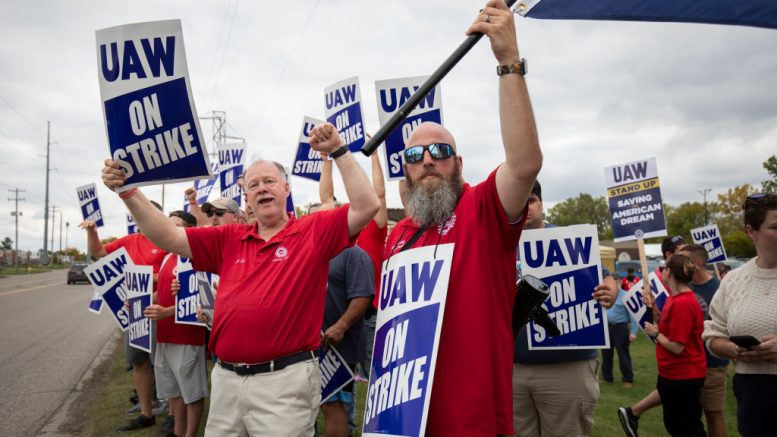The laws that helped pull unionization down to near 10% remain on the books — but six out of 10 U.S. adults now say declining unionization is bad for the country.
By Mark Kreidler, Capital & Main
This story is produced by the award-winning journalism nonprofit Capital & Main and co-published here with permission.
For organized labor in the U.S., 2023 was a year of strikes that made national news and resulted in high-profile negotiating victories. From the sidewalks of Hollywood and New York to assembly plant floors in Detroit and beyond, the phrase “hot labor summer” arrived in full fury.
And despite a year that felt full of breakthroughs, the future of unions in this country is indeed an open question.
The union membership rate in the U.S. for 2022 fell to the lowest level ever recorded at 10.1%, according to the federal Bureau of Labor Statistics. That is barely half the 20.1% unionization rate that existed in 1983, the first year for which comparable data are available.
Numbers for 2023 are due early next year from the BLS, but union rates have been on a downward trajectory for 40 years with virtually no interruption. At the same time, public support for unions in America is near 50-year highs, and six in 10 adults say the reduction in union representation has been bad for the country.
So what’s going on?
* * *
For the answer, you have to pull way, way back from a one-year window like ’23. The larger truth, for union organizers and the workers who could benefit from their representation, is that decades of comically one-sided labor laws and legal decisions have favored employers and corporations over those who try to form unions, conduct union elections or, eventually, negotiate contracts.
Moreover, “The politics are really difficult,” said Sharon Block, a professor and the executive director of the Center for Labor and a Just Economy at Harvard Law School. “Anyone who would tell you they’re optimistic that big labor law reform is going to pass in the near term is either not being truthful or is delusional.”
Since its passage in 1935, the National Labor Relations Act has been meaningfully modified only once, in 1947. “And that was a retrenchment,” Block said this summer, in a reference to passage of the Taft-Hartley Act. The measure placed significant restrictions on union organizing and allowed individual states to pass “right to work” laws, meaning workers in those states could benefit from union-negotiated contracts without being required to join or pay dues. Twenty-six states have enacted such laws. (California is not one of them.)
Taft-Hartley and several individual court decisions have combined to make it far tougher for unions to form, labor experts say. Under federal law, employers can force workers to attend “captive audience speeches” in which companies argue against union representation. Union elections themselves must be conducted at the workplace — “the center of the employer’s control and authority over the worker,” Block said.
And even a massive workforce like that of Starbucks has to be unionized one single store at a time, per U.S. law. According to the organizing group Starbucks Workers United, more than 360 stores have now unionized across the country, but Starbucks has more than 9,000 company-run stores domestically and another 6,500 that are licensed to other operators.
The Starbucks experience highlights the law’s corporate tilt. Among the coffee chain’s unionized stores, not one has yet achieved a contract. Why? Among other things, it’s because there is no real penalty levied by the governing National Labor Relations Board against companies that refuse to negotiate meaningfully.
“It can be difficult to prove that there has been a failure to bargain in good faith,” said Michigan State University labor expert Michelle Kaminski. “It can take a long time. And even if there is proof, the remedy is simply to tell the two parties to go back and bargain in good faith. The penalties absolutely do not have any kind of deterrent power.”
* * *
All of these factors stand between workers and their ultimate goal: a contract with wages, benefits and protections that provide them a stable living. If nothing else, 2023 ought to be remembered as an example of the critical role unions can play in that process.
Both the Writers Guild of the America and the actors union SAG-AFTRA achieved significant gains and protections after protracted strikes against the Hollywood corporations that negotiate as a behemoth collective. More than 70,000 Kaiser Permanente workers won pay raises totaling 21% by 2027. The United Auto Workers ratified deals with the Big Three automakers that include raises of at least 25% over four and a half years, while the Teamsters and UPS negotiated a five-year contract with substantial wage gains and worker safety enhancements, among other things.
Collectively, hundreds of thousands of U.S. workers will benefit from those new contracts. While other negotiations are ongoing, including those involving the Los Angeles hotel strikes that affect some 15,000 workers, this year will go down as one in which milestone deals were ratified and unions showed the kind of power they can harness.
That power, though, still relies on the unions’ ability to first organize workers and then bring unwilling employers to the bargaining table. In 2024 and beyond, that prospect continues to be daunting so long as the unions have to fight federal labor laws, too.
Copyright 2023 Capital & Main


I hope federal unions are gearing up for an existential battle if the Trump Dictatorship(tm) gets in power. I hope they are a lot better than our state unions, who are more interested in pushing Disneyland tickets than any kind of effective job action… couldn’t even muster up a scare during contract negotiations, during “hot strike summer,” even while we watched those other victories.